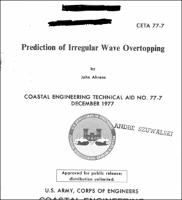Please use this identifier to cite or link to this item:
https://hdl.handle.net/11681/2826| Title: | Prediction of irregular wave overtopping |
| Authors: | Coastal Engineering Research Center (U.S.) Ahrens, John P. |
| Keywords: | Irregular wave overtopping Irregular wave runup Irregular waves Wave overtopping Wave runup |
| Publisher: | Coastal Engineering Research Center (U.S.) |
| Series/Report no.: | Coastal engineering technical aid ; no. 77-7. |
| Description: | Technical aid Abstract: Rates of wave overtopping of structures can be predicted by means of an equation presented in the Shore Protection Manual (SPM)(eg. 7-6, U.S. Army, Corps of Engineers, Coastal Engineering Research Center, 1975; Weggel, 1976). Implicit in the use of this equation is the assumption of monochromatic waves; i.e., waves of uniform height and period. A question that arises is what would the overtopping rate be for irregular wave conditions having a significant height equal to the height of the monochromatic wave used in the SPM equation? To develop an answer to this question, the irregular wave conditions are assumed to cause the runup to have a Rayleigh distribution of the type commonly associated with wave heights. This technique, which was used by Ahrens (1977) to predict irregular wave runup, appears reasonable but possibly somewhat conservative. The runup with a Rayleigh distribution is used in the SPMts wave overtopping equation to predict average overtopping rates for irregular waves having a particular significant height. This approach generally yields overtopping rates that are considerably lower than the corresponding monochromatic rates except for structures with high relative freeboards where the irregular wave overtopping rates can then exceed the monochromatic rates. This behavior is consistent with the trends observed by Tsuruta and Goda (1968) in their laboratory study of overtopping caused by both monochromatic and irregular waves. Example problems are given to illustrate how this technique can be used to predict overtopping rates for irregular wave conditions. A table, which can be used to calculate the irregular overtopping rate using the monochromatic rate for equivalent wave conditions is also given. |
| Rights: | Approved for Public Release, Distribution is Unlimited |
| URI: | http://hdl.handle.net/11681/2826 |
| Appears in Collections: | Coastal Engineering Technical Aid |
